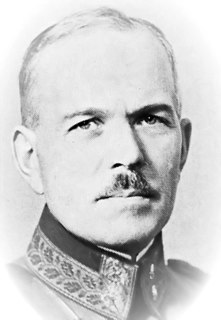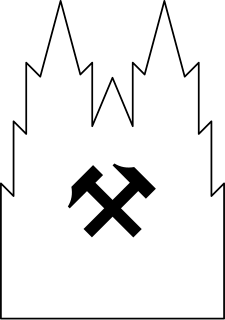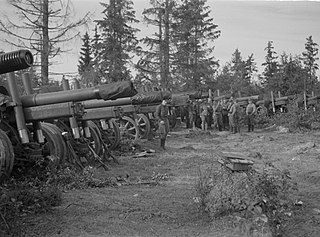
The Winter War was a war between the Soviet Union (USSR) and Finland. It began with a Soviet invasion of Finland on 30 November 1939, three months after the outbreak of World War II, and ended three and a half months later with the Moscow Peace Treaty on 13 March 1940. Despite superior military strength, especially in tanks and aircraft, the Soviet Union suffered severe losses and initially made little headway. The League of Nations deemed the attack illegal and expelled the Soviet Union from the organisation.
The Mannerheim Cross of Liberty is the most distinguished Finnish military honour.

Axel Erik Heinrichs was a Finnish military general. He was Finland's Chief of the General Staff during the Interim Peace and Continuation War and commander-in-chief for a short time after the war (1944–1945).

The Finnish Army is the land forces branch of the Finnish Defence Forces. The Finnish Army is divided into six branches: the infantry, field artillery, anti-aircraft artillery, engineers, signals, and materiel troops. The commander of the Finnish Army since 1 August 2017 is Lieutenant General Petri Hulkko.

Karl Lennart Oesch was one of Finland's leading generals during World War II. He held a string of high staff assignments and front commands, and at the end of the Continuation War fully two-thirds of the Finnish ground forces were under his command. Oesch earned a reputation of being able to deal with difficult situations, a trait that Mannerheim used fully.
The II Corps was a unit of the Finnish Army during the Winter War.

IV Corps was a corps-sized formation of the British Army, formed in both the First World War and the Second World War. During the First World War the corps served on the Western Front throughout its existence. During the Second World War it served in Norway and Britain until, after Japan entered the war and India was threatened with attack, it was transferred there.
The 4th Division was a unit of the Finnish Army during the Winter War. It was part of the II Corps which fought on the Karelian Isthmus. The 4th Division was responsible for the front between the Gulf of Finland and Viipuri.

The Battle of Narva was a military campaign between the German Army Detachment "Narwa" and the Soviet Leningrad Front fought for possession of the strategically important Narva Isthmus on 2 February – 10 August 1944 during World War II.
The Karelian Army was a Finnish army during the Continuation War.
The III Corps was a unit of the Finnish Army during the Winter War. The III Corps with the II Corps formed the Army of the Isthmus. For most of the war it defended the Mannerheim Line on the northern side of the River Vuoksi against Soviet attacks.

The Finnish invasion of Ladoga Karelia refers to a military campaign carried out by Finland in 1941.
The 9th Army of the Soviet Union's Red Army was a Soviet field army, active from 1939–43.
The 8th Army was a field army of the Soviet Red Army during the Second World War.

The 10th Army of the Soviet Union's Red Army was a field army active from 1939 to 1944.

The 227th Infantry Division named "Rheinisch-Westfälische" was created on 26 August 1939 in Krefeld. The division was deployed for the last time in February 1945 in the Tuchola Forest.
The 5th Division was a unit of the Finnish Army during the Winter War. It was part of the II Corps which fought on the Karelian Isthmus as part of the Army of the Isthmus. It was stationed on the Mannerheim Line between Lake Muolaanjärvi and Kuolemajärvi.
The 142nd Rifle Division began service in August, 1939 as a standard Red Army rifle division, which participated in the Winter War against Finland. It remained on the Karelian Isthmus and had a relatively uneventful war facing the Finns until the Vyborg–Petrozavodsk Offensive began on June 10, 1944, from which point it saw much more active service. Following the end of the Continuation War, the division was transferred to 2nd Shock Army in 2nd Belorussian Front. Its soldiers distinguished themselves in the capture of the German city of Graudenz and ended the war fighting through Pomerania.
The 49th Rifle Division was a Soviet Army infantry division, formed three times. First formed as a territorial division in 1931, the 49th Rifle Division's first formation became a regular division by 1939 and fought in the Winter War. For its actions during the war, it was awarded the Order of the Red Banner. However, the 49th Rifle Division was wiped out during the first ten days of Operation Barbarossa. Its second formation occurred in December 1941 and fought at Stalingrad, Kursk, the Vistula-Oder Offensive and the Battle of Berlin. The second formation was disbanded in 1946. The division was reformed in 1955 by renaming the 295th Rifle Division and became the 49th Motor Rifle Division in 1957.

The Battle of Porlampi, also known as the Battle of Porlammi, was a military engagement fought between the Finnish Army and Red Army from 30 August to 1 September 1941 on the Karelian Isthmus. The battle was fought near the town of Porlampi during the second month of the Continuation War. The battle was a Finnish victory and effectively ended the reconquest of Karelia.










